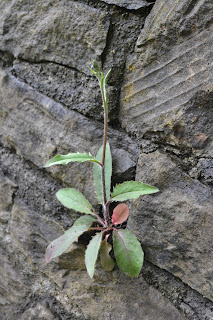|
Royal fern
Kitetail
|
From Morgans Hotel,
an old building that used to be the port’s shipping offices, we walked east
down Somerset Place
and over the river Tawe by footbridge (Abertawe is the Welsh name for Swansea). We reached the Prince of Wales Dock and the
new waterfront development including many restaurants, and the usual
statuesque Cormorant on a post in the water.
Here we again picked up the official coast path. This took us beside and then over the A483
and along the bank of the Tennant Canal
through Port Tennant, where we saw Irregular-toothed Hawkweed Hieracium lepidulum on a wall. The path borders the Crymlyn Bog NNR, but
all that could be seen from this route was reed-marsh and there was no
possibility of recording any bog plants unfortunately. We did, however, record a series of wetland
ones like Great Tussock-sedge, Royal Fern and Blackcurrant. After this pleasant section we passed
through lines of pylons serving the surrounding industrial areas and left the
canal at Jersey Marine, returning beside a road to the A483 and following
this just past the M4 interchange. We
turned right along the A48 to cross the river Nedd (Neath) and reach the
roundabout at the south end of the town of Neath. We took a South-Westerly direction through an
industrial area and to the bank of the Nedd, where remains of a lock designed
by Brunel were preserved. Shortly we
had to leave the river to walk just outside the long security fence around a
large industrial area, although most of this was now derelict wasteland. We were walking beside saltmarsh with Sea
Purslane. We then entered the dunes of
Baglan Burrows, which were rather disturbed, but had Sea Holly, Sea Bindweed
and a good scattering of Isle of Man Cabbage, noticeable for its deeply cut
leaves. After lunch here, overlooking
inland factories and wasteland on the leeward side of the dunes out of the
cold wind, we walked out Aberavon Beach,
where there was a limited range of shells, including many Pharus legumen and Scallops. We continued down the firm sand, rather
than through the soft sand of the dunes, as far as the start of the housing
of Port Talbot, where there began the new
Aberavon seafront promenade development with many new buildings, playgrounds,
and garden areas. In the mid-C20th
this had been a popular seaside resort, which had subsequently gone into
decline with the loss of the area's economic infrastructure, but in the last
decade of the century a regeneration plan was carried out. Although this seems to have stalled
somewhat (eg lack of restaurants and other commercial facilities, and an
"unfinished" appearance), it is now a surprisingly pleasant
promenade for an industrial town. It
being Sunday, this area was busy with families. The view south-east is dominated by the
stacks and smoke plumes of Port Talbot Power Station. At the centre of the promenade is a large
sculpture (reputedly the largest in Wales)
called the "Kitetail" by Carmarthen
artist Andrew Rowe. 12 metres high and
weighing 11 tons, it was erected in 2007.
It was inspired by the arcs inscribed by the strings of kites (not by
the forked tail of red kites). At the
far south-eastern end of the promenade there is a small area of relict dunes
with Annual Wall-rocket prominent, a good number of plants of Sea Stock, and
several sculptures celebrating sea life containing metal plaques that appear
to have been based on individual children's designs. These represented, among others, Sea Stock,
Sea Holly, Marram and Sea Bindweed, all to be seen beside the sculptures, but
also lichens, mussels, limpets, netted dog whelks, fish, starfish, crabs,
seaweed, and even plankton and beach debris.
We arrived at the mouth of the River Afan and the docks serving the
industrial site beyond. We skirted the
docks along the canalised river with Canada and Domestic Geese and
Mute Swans. Dark storm-clouds gathered
dramatically above the hill of Mynydd Dinas at the back of Port
Talbot. A Mayfly Ecdyonurus venosus landed on Val’s
dark glasses and was reluctant to leave them, presumably regarding them as
the latest must-have insect accessory.
Arriving at a roundabout we took the coast path route marked on the OS
map along a back street to Port
Talbot Parkway railway station, where we could
catch a train back to Swansea,
being the main line from Paddington now once more known by the old name of
GWR. (Signs for the coast path on the
ground now seem to indicate a new route along a dual carriage-way about 100m
away from the old route but parallel to it; but this unfortunately omits the
useful station.)
|
Irregular-toothed hawkweed
Blackcurrant
|
















No comments:
Post a Comment